The Best Home Medical Alert Systems of 2025

Key Findings
- Medical Guardian home medical alert systems connected us to help in an average of eight seconds.
- Bay Alarm Medical systems connected us to help in an average of 16 seconds; however, they tend to be cheaper than Medical Guardian’s.
- ADT’s home medical alert systems were incredibly durable and easy to use.

Why Trust Us?
At TheSeniorList, our team of caregivers, experts, and healthcare professionals conducted over 5,000 hours of in-depth research and testing to recommend the most reliable brands and devices. In this process, our team:
- Tested 50 medical alert devices from 15 different brands.
- Surveyed 1,250 seniors and caregivers on medical alert system usage.
- Consulted with nurses, EMTs, and caregivers who are experts at caring for older adults.
- Published dozens of videos that demonstrate our medical alert system testing.
- Evaluated verified customer reviews of medical alert companies from the Better Business Bureau.
How We Test Medical Alert Systems

When choosing the best in-home medical alerts, here is how we evaluated them:
- Quick response times: At the end of the day, a medical alert system is a communicative device that links people in need to trained response agents. I look for companies that will answer distress calls in under 20 seconds.
- Durable equipment: A medical alert system should be with you for the long haul, so I tested devices to make sure they could withstand occasional falls or drops. Bonus points went to systems with waterproof buttons, since the bathroom is one of the most common sites of falls.
- Accurate fall detection: Now a standard add-on feature of medical alert systems, fall detection is particularly useful for people with mobility or dexterity issues. Many fall-detection buttons trigger false alarms, however, so I tested them for accuracy.
- Caregiver features: A quality in-home system can keep a person safe around the house, but I also appreciate when medical alerts include companion apps or caregiver portals. That allows people to keep better track of their loved one’s overall wellness.
- Straightforward pricing: Unless you’re being offered a substantial discount, you should never lock into a long-term contract for a medical alert system. Every system on this list offers month-to-month pricing and free trial periods.
FYI: Looking for medical alert systems for $19.95 per month? Read our guide to this year’s best medical alert systems.
Our Favorite Home Medical Alert Systems
- Bay Alarm Medical : Best for Landline
- Medical Guardian : Fastest Response Time
- ADT : Best Waterproof
- UnaliWear Kanega Watch : Best With Fall Detection Included
1. Bay Alarm Medical - Best for Landline
What We Like Most:
- Accurate location data
- 32-hour battery backup
- Up to five years of battery life for the standard help button
- Waterproof help button
Overview

Bay Alarm Medical’s SOS Home system connects to your landline, ensuring that emergency responders will have accurate location data.
Standout Features

It’s not quite as fast as Medical Guardian, but Bay Alarm Medical’s 16-second response time in my tests was certainly on the faster side. With the SOS Home, I used the Bay Alarm Medical app to track the help button’s location and battery level. I added an extra fall-detection pendant, which costs extra up front and per month (more on that below).
The SOS Home system consists of a base station and a waterproof help button you can wear 24/7 — even in the shower. In my tests, it worked as long as I was within 1,000 feet of the base station. The system is dependent on a landline, but the base station’s battery lasts 32 hours, giving you a backup in case of a power outage. The help button itself has a five-year battery life, while the fall-detection button has a two-year battery life. You wouldn’t need to charge either for the lifetime of the devices, which is ideal for someone with memory issues such as Alzheimer’s or dementia.
Pricing
The SOS Home’s equipment is free, other than the optional $30 fall-detection pendant. It’ll be $24.95 on a monthly basis, or $39.95 with fall detection. If you decide to go the cellular route without fall detection, the price is $29.95. All contracts are monthly and there are no activation fees. You can learn more about Bay Alarm’s pricing here.
Drawbacks
Like the MyGuardian app, the Bay Alarm Medical app has ample room for improvement. It would be helpful if it notified me when my battery was low rather than making me check it manually. For a busy caregiver, that could slip by the wayside.
Our Verdict
With monthly contracts, a waterproof help button, and optional fall detection, Bay Alarm Medical’s SOS Home system is the best in-home system for landlines. To learn more about Bay Alarm Medical, check out our full review of Bay Alarm Medical’s systems.
Pros
- Waterproof help button
- Caregiver tracking
- Landline-compatible
- Monthly contracts
Cons
- Not the best app
- Fall detection costs $10 extra per month, plus $30 up front for the device
2. Medical Guardian - Fastest Response Time
What We Like Most:
- Eight-second response time
- Caregiver tracking
- Optional fall detection
- 32-hour battery backup
Overview

Of all the medical alert systems I’ve tested, Medical Guardian connected me to help the fastest, averaging eight seconds across my test calls.
Standout Features

I tested the MGHome Cellular from Medical Guardian. The package came with a hub, as well as a medical alert button I could wear as either a bracelet or a necklace. Whenever I pressed the button, I got a response from the monitoring team in as little as eight seconds — the fastest response time I’ve seen. I recommend adding fall detection. During my test fall, I didn’t have to press a button to get the help I needed (in theory.)
Another feature I loved was the amount of caregiver tracking the system allowed via the MyGuardian app. Using the app, caregivers can chat with each other and see the pendant’s location, battery history, system status, and connectivity history, ensuring that it’s up and running.
Because it’s a home system, the pendant will work only if you’re within 1,400 feet of the hub. That’s actually the longest range on this list, so it’s a good option for people with larger homes.
Pricing
I paid $149.95 for the MGHome Cellular system equipment. Monitoring prices range from $34.95 to $39.95 per month. You can save money by signing up for a year as opposed to a month or quarter. To add fall detection, you’ll have to pay an additional $10 per month. To learn more, read our guide to Medical Guardian’s pricing.
Drawbacks

I had an easy time tracking the devices on the web portal, but the MyGuardian app had somewhat limited features, at least for in-home systems.
Our Verdict
If response time is the most important thing to you, you’ll love the cellular at-home system from Medical Guardian. To learn more, check out my full review of Medical Guardian.
Pros
- Fast response time
- Caregiver tracking
- Cellular and landline systems available
- Optional fall detection
Cons
- Fall detection costs an extra $10 per month
- Subpar mobile app
3. ADT - Best Waterproof
What We Like Most:
- Waterproof help button
- No equipment fees
- 14-second response time
- Temperature monitoring
Overview

Other than the Kanega Watch, ADT Health’s Medical Alert Plus is the only truly waterproof — not just water-resistant — help button on this list.
Standout Features

You may know ADT from its home security, but it also sells medical alert systems. I tested the Medical Alert Plus, a home package that consists of a hub and pendant or wristband. I added fall detection, which requires a separate device. Like the Aloe Essentials hub, ADT’s version also tests a home’s temperature, but it doesn’t check air quality. It was nice to know the actual temperature without depending on my iPhone’s weather app, which is a notorious liar. I could use the pendants as long as I was within 600 feet of the hub. Since they’re waterproof, I took them in the bath with me and immersed them completely underwater. They worked, no problem.
One thing I tested immediately was the response time. It was 14 seconds, which was the second-fastest on this list after Medical Guardian.
Pricing
ADT offers free equipment. Without extra fall detection, the plans range from $33.99 to $37.99 a month. That’s about average when it comes to medical alerts. Plans are either monthly, quarterly, or annually, and you can get a discount if you sign up for longer. With fall detection, prices go up $33 a quarter, or $8.25 per month. That’s less than the industry-standard $10 per month. There are no activation fees. You can learn more about the costs of ADT Health.
Drawbacks
ADT offers the SoSecure app, which lets caregivers track your location. It works only through phones, though, not the medical alert devices. It also costs extra — $4.99 a month or $49.99 a year. You’re better off turning on location sharing. ADT Health also doesn’t offer caregiver tracking with its medical alert systems.
Our Verdict
If you want a waterproof, home system from a brand you can trust, considering ADT Health’s Medical Alert Plus. To learn more about my experience with ADT’s systems, check out my full review of ADT’s medical alerts.
Pros
- Temperature monitoring
- Waterproof device
- Fast response times
- No equipment fees
Cons
- No caregiver tracking for medical alert devices
- Fall detection requires a separate device and fee
4. UnaliWear Kanega Watch - Best With Fall Detection Included
 View Packages
Links to UnaliWear Kanega Watch
View Packages
Links to UnaliWear Kanega Watch
What We Like Most:
- Fall detection included in price and device
- Waterproof device
- No equipment fee
- One month free for veterans and AARP members

Overview

The Kanega Watch is the only medical alert I’ve tested that has fall detection. It’s technically not a home system, but you can wear it in and out of your home 24/7 because of its battery system and cellular and Wi-Fi connectivity.
Standout Features

The Kanega Watch is the only product available from UnaliWear, but it has the best features on the market. It connected to my Wi-Fi network when I was at home and a cellular network when I was out, which ensured that I always stayed connected. It has rechargeable batteries that are super easy to slip in and out, and the watch comes with four batteries and two chargers. Combine that with its waterproof design, and I never had to take off the Kanega Watch during testing. It’s also available in four sizes, so it’ll work whether you have tiny wrists like me or big, strong wrists that require an extra-large band.
Because there’s no hub, I could wear the Kanega Watch anywhere with a Verizon network, which means the large majority of the U.S. To get connected with emergency services, all I had to do was push the button or take a fall, since fall detection is included in the watch itself.
Pricing
UnaliWear technically doesn’t charge anything for equipment, but its $199 activation fee ($299 if you activate over the phone and not online) more than covers it. Beyond the fee, prices are either $59.95 a month if you sign up for a year or $69.95 with a flexible monthly contract. That may sound steep, but fall detection, which is normally around $10 a month, is included. AARP members and military veterans get one month free, and everyone can benefit from the 30-day money-back guarantee.
Drawbacks
UnaliWear has yet to make an app, so there’s no caregiver tracking. The other clear drawback is its steep activation fees, especially since ADT Health and Bay Alarm Medical have none whatsoever. Combine that with monthly prices on the higher side, and it isn’t a good option for people on a budget.
Our Verdict
With included fall detection, rechargeable batteries, and a waterproof design, the Kanega Watch is the medical alert watch that stays on 24/7. You can dive deeper in our full Kanega Watch review.
Pros
- Waterproof
- Fall detection included
- Four rechargeable batteries
- Free month for AARP members and military veterans
Cons
- High activation and monthly fees
- No caregiver tracking
Why Purchase an In-Home Medical Alert System?
Older adults are at a higher risk of falling than the rest of the population, and it’s easy for falls to happen at home. The bathroom, kitchen, and laundry room are particularly dangerous places for slips and falls, since they tend to have slick surfaces that are often wet. There are also risks associated with stairs, rugs, and badly positioned furniture. Having an in-home medical alert means help can be on the way in seconds if a fall happens.
Older adults who mostly stay at home need a reliable medical alert system they can trust. It gives caregivers extra peace of mind too. They can rest assured that their loved ones are protected even when they’re not around.
Getting help quickly in the event of a fall or other medical incident makes a big difference. A medical alert means caregivers or EMTs are on the scene quickly, and older adults are not stuck, unable to get help. Getting up or to the hospital faster has a positive effect on recovery times.
Landline vs. Cellular Medical Alert Systems
When it comes to home systems, you have two options: a landline or cellular system.
Landline systems, obviously, require landlines, which most people don’t have at this point. They do, however, have one big advantage over cellular systems: more accurate location data.
In order to keep working during a power outage, most landline hubs have built-in backup batteries.
Nearly 48 percent of U.S. adults ages 65 or over live in wireless-only households, according to the Centers for Disease Control and Prevention, which means they don’t have landlines. If that’s the case for you, a cellular system is a good option for your home. Any mobile system will use cellular data, which is always included in the monthly cost of your system. No matter which system you choose, you’ll be able to stay connected with the monitoring center 24/7, and they’ll be able to determine your location.
What to Look for When Choosing an In-Home Medical Alert
With so many medical alerts on the market, it can be hard to know which one to choose. Below are some must-have features to consider when selecting an in-home medical alert.
- Straightforward pricing: No one likes hidden costs, so be sure the pricing and terms are clear and free of any hidden fees, such as activation or shipping fees.
- Comfortable help buttons: The only way to stay protected is to keep your button on at all times, so comfort is a must. People I care for generally prefer silicone wristbands, since they’re form-fitting and odor-free.
- Fall detection: For older adults at home, fall detection is an important add-on. It helps ensure that help will still arrive even if they can’t press their button.
- Water-resistant devices: The bathroom is one place where seniors need extra protection in case a fall happens. I prefer water-resistant — or, even better, waterproof — help buttons so you can remain protected while bathing.
- Backup battery: Since in-home medical alert systems are powered through wall outlets, your system should have a backup battery of at least 24 hours, ensuring that your loved one can remain protected during a power outage.
Can You Use a Mobile System at Home?
Is it possible to use a mobile system within the home? In most cases, the answer is yes. There are, however, a few caveats I want to point out.
- Charging: Hubs and base stations rely on your home’s power and fall buttons often have batteries that last years, but mobile systems typically require charging. While your device is charging, you may not be protected, making you more vulnerable physically.
- Larger: Mobile fall buttons are larger than their in-home counterparts, so you may not want to wear them 24/7 — especially if they’re heavy on your neck or wrist.
- Not necessarily waterproof: Mobile systems may be water-resistant but not waterproof, which means you shouldn’t completely submerge them in water. If you want a system you can wear all the time, even in the bath, look for waterproof devices with IP ratings of 68.
- More expensive: Mobile systems tend to cost more than at-home systems, so keep equipment, activation, and monitoring fees in mind.
Bottom Line
At-home systems make it easy to stay safe in the confines of your home and let caregivers make sure you’re safe as well. They tend to be cheaper than mobile systems and do not require charging, which means you can wear the buttons 24/7 to stay protected all day.
Frequently Asked Questions
-
Are home medical alert systems more reliable than mobile systems?
Home medical alert systems may be more reliable than mobile systems for a few reasons. First, they depend on a home’s power and do not require charging (most include battery backups for power outages). Second, if they connect to your landline, they have more accurate location data than mobile systems that use cellular networks. Third, they’re often waterproof instead of just water-resistant, which means they’ll work even after wearing them in the shower or bath.
-
Which home medical alert system is best?
The best home medical alert systems are:
- ADT Health’s Medical Alert Plus
- Aloe Care Health’s Essentials package
- Bay Alarm Medical’s SOS Home
- Medical Guardian’s MGHome Cellular
- UnaliWear’s Kanega Watch
-
Which home medical alert systems have fall detection?
Some home medical alert systems with fall detection include:
- ADT Health Medical Alert Plus: Requires an extra device that costs $33 a quarter
- Bay Alarm Medical SOS Home: Requires an extra device that costs $30 up front and $10 per month
- Kanega Watch: No extra cost or additional device required
- Medical Guardian MGHome Cellular: Costs an extra $10 per month
-
Are landline systems better than cellular?
In terms of location data, landline systems are better than cellular systems. They will work in a power outage only if the hub has a built-in backup battery, however, while cellular systems will stay connected regardless.




